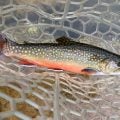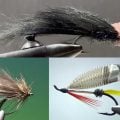Review: “Good Flies”
When I picked up Good Flies: Favorite Trout Patterns and How They Got That Way by John Gierach late Sunday morning, I was surprised to see a 2000 copyright. I need to spend more time browsing the shelves of the local Gibson’s Book Store.Gierach’s writing appeals to me the way Ernest Hemingway attracts English majors. He uses a vivid down-to-earth style combined with an expert’s understanding of his subject matter. The Colorado-based writer has also been recognized as a master of the one-liner. He offers a sometimes hilarious insight into the sport and those who enjoy it.
“Tying our own flies is where many of us go off the deep end with fly fishing,” reads the opening line of the book. Like a good lead in a newspaper story — and most of his books are expanded collections of newspaper columns — it introduces both the subject matter and the author’s attitude.
That attitude is what keeps drawing me back to Gierach’s books. He knows the sport inside out, and his profession has taken him to more famous fishing destinations than most of us could dream about. For a guy who fishes with bamboo rods, he knows how to poke fun at the snootier aspects of fly fishing and fly fishermen.
Good Flies is as much about the experience of fishing the subject matter as it is a modestly technical manual explaining how to tie the listed patterns. If you are looking for a basic how-to manual, this isn’t the book for you. On the other hand, if you understand basic fly tying techniques, his tips and specific patterns should help you assemble workable artificials.
As a tier who confesses to attempting full-dress Atlantic salmon flies, Gierach understands the pull between practicality and artistry in tying flies. Some flies are meant to be displayed. The more effective ones are destined to be chewed by more than one fish.
The 12-page introduction lays out Gierach’s personal history of simultaneously taking up both fly fishing and fly tying. Like the beginner eager to catch as many small trout as possible, he tied and fished every pattern he could get his hands on.
Over 30 years, he pared his selections to “a core handful of patterns that I tie the same way year after year, that I usually either start with or come back to, and that in fact catch most of my fish.”
He describes his selection as regional to the Rocky Mountain West. Eastern anglers will recognize many of the patterns. Giarach describes an “inordinate fondness” for freestone streams as well as lakes. If you live in New Hampshire, as I do, you’ll find plenty of freestone steams — the ones with the clear water flowing over rounded gravel and small stones — in the White Mountains. Much of our state’s trout fishing takes place on ponds.
It shouldn’t come as any surprise that a book on good flies would devote four chapters to mayflies: small, medium, large and spinners (the dead and dying insects that have laid their eggs). Casting mayfly patterns is primarily dry fly fishing, and I understand the author’s love for it:
“For as long as I’ve fished with a fly rod, I’ve had a self-conscious weakness for dry flies; first because of their puffed-up classiness, later in spite of it. Dry-fly fishing may or may not be the most demanding way to catch fish, but everything about it is visual and beautiful and I’ve always been a sucker for that kind of thing.”
I’ve always liked Gierach’s writings about caddis flies, which he describes as the opposite of mayflies.
“Mayflies are slow and float quietly on the water, but caddis flies are busy and blast off as if they actually understand that you’re trying to eat them. Mayflies are ephemeral — here and gone in a day or two — but caddis flies live for weeks, and some are always around. Mayflies in flight look like angels. Caddis flies look like moths on speed.”
He offers an interesting philosophical look at nymph fishing and recognizes the effectiveness of “chucking lead” over casting a dry, but quotes Lee Wulff’s belief that fish deserve the sanctuary of the depths. Still, Gierach doesn’t get too preachy on the subject. “I usually start thinking about the idea of sanctuary on about the third or fourth fish,” he writes.
In the concluding chapter on streamer fishing, Gierach offers the theory that fishing the baitfish imitations is much less scientific than using insect patterns. He suggests that flies that resemble sculpin or other minnows may not be any more effective than flies offering a little flash and color.
If heavy rain and high water force you inside, Good Flies will keep you entertained and perhaps hunched over your fly tying vise.












